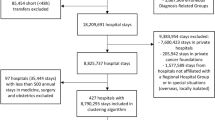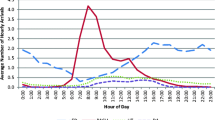Abstract
Spiraling health care costs in the United States are driving institutions to continually address the challenge of optimizing the use of scarce resources. One of the first steps towards optimizing resources is to utilize capacity effectively. For hospital capacity planning problems such as allocation of inpatient beds, computer simulation is often the method of choice. One of the more difficult aspects of using simulation models for such studies is the creation of a manageable set of patient types to include in the model. The objective of this paper is to demonstrate the potential of using data mining techniques, specifically clustering techniques such as K-means, to help guide the development of patient type definitions for purposes of building computer simulation or analytical models of patient flow in hospitals. Using data from a hospital in the Midwest this study brings forth several important issues that researchers need to address when applying clustering techniques in general and specifically to hospital data.
Similar content being viewed by others
REFERENCES
Institute of Medicine. Committee on Quality of Health Care in America, Crossing the Quality Chasm: A New Health System for the 21st Century, National Academy Press, Washington, DC, 2001.
Hancock, W. M., and Chan, T., Productivity and staffing of hospital units with uncertainty in the demand for service. IIE Trans. 20:346–353, 1988.
Lapierre, S. D., Goldsman, D., Cochran, R., and DuBow, J., Bed allocation techniques based on census data. Soc. Econ. Plann. Sci. 33:25–38, 1999.
Bradley, D. J., and Martin, J. B., Continuous personnel scheduling algorithms: A literature review. J. Soc. Health Syst. 2:8–23, 1991.
Cohen, M. A., Hershey, J. C., and Weiss, E. N., Analysis of capacity decisions for progressive patient care hospital facilities. Health Serv. Res. 15(2):145–160, 1980.
Lowery, J. C., and Martin, J. B., Design and validation of a critical care simulation model, J. Soc. Health Sys. 3:15–36, 1992.
Weiss, E. N., Cohen, M. A., and Hershey, J. C., An iterative estimation and validation procedure for specification of semi-Markov models with application to hospital patient flow. Oper. Res. 30(6):1082–1104, 1982.
Health Services Engineering, Inc. Obstetrics Simulation Study, Department of Defense Contract DASW01–95–0028, 1997.
Kao, E. P. C., and Tung, G. G., Bed allocation in a public health care delivery system. Manag. Sci. 27(5):507–520, 1981.
Blumberg, M. S., Distinctive patient facilities concept helps predict patient bed needs. Mod. Hosp. 97:75–81, 1961.
Vassilacopoulos, G., A simulation model for bed allocation to hospital inpatient departments. Simulation 45:233–241, 1985.
Isken, M. W., Computer simulation in management engineering. In Larson, J. A. (eds.), Management Engineering, Health care Information and Management Systems Society, Chicago, pp. 179–196, 2001.
Fetter, R. B., Diagnosis related groups: Understanding hospital performance. Interfaces 21(1):6–26, 1991.
Agency for Health Care Research and Quality. Clinical Classifications Software. Fact Sheet, Rockville, MD. http://www.ahcpr.gov/data/hcup/ccsfact.htm.
Public Health Service and Health Care Financing Administration. International Classification of Diseases, 9th Revision, Clinical Modification, Public Health Service, Washington, DC, 1994.
Roth, A. V., and Van Dierdonck, R., Hospital resources planning: Concepts, feasibility, and framework. Product. Oper. Manag. 4(1):2–29, 1995.
Everitt, B. S., Cluster Analysis, Halstead Press, New York, 1993.
Balakrishnan, P. V., Cooper, M. C., Jacob, V. S., and Lewis, P. A., A study of the classification capabilities of neural networks using unsupervised learning: A comparison with K-means clustering. Psychometrika 59(4):509–525, 1994.
Cardoso, M. G. M. S., Themido, I. H., and Pires, F. M., Evaluating a clustering solution: An application in the tourism market. Intell. Data Anal. 3:491–510, 1999.
Lludeman, L. C., Document Retrieved April 4, 2001, from http://www.ece.nmsu.edu/ lludeman/ video/chp6pr html.
Bradlow, E., and Hutchinson, W., How I do choose the optimal number of clusters in cluster analysis? In Iacobucci, D. (ed.), Methodological and statistical concerns of the experimental behavioral researcher. J. Consum. Psychol. 2001.
Arabie, P., How I do choose the optimal number of clusters in cluster analysis? In Iacobucci, D. (ed.), Methodological and statistical concerns of the experimental behavioral researcher. J. Consum. Psychol. 2001.
Koehly, L., How I do choose the optimal number of clusters in cluster analysis? In Iacobucci, D. (ed.), Methodological and statistical concerns of the experimental behavioral researcher. J. Consum. Psychol. 2001.
Wansink, B., and Park, S. B., Methods and measures that profile heavy users. J. Advert. Res. July-Aug.:61–72, 2000.
Meila, M., and Heckerman, D., An Experimental Comparison of Several Clustering and Initialization Methods, Technical Report MSR-TR-98–06, Microsoft Research, 1998.
Dhillon, I. S., Fan, J., and Guan, Y., Efficient clustering of very large document collections. In Grossman, R., Kamath, C., Kumar V., and Namburu, R. (eds.), Data Mining for Scientific and Engineering Applications, Kluwer, Dordrecht, 2001.
Isken, M. W., Littig, S. J., and West, M., An operations analysis data mart. J. Healthcare Inform. Manag. 15(2):143–154, 2001.
Author information
Authors and Affiliations
Corresponding author
Rights and permissions
About this article
Cite this article
Isken, M.W., Rajagopalan, B. Data Mining to Support Simulation Modeling of Patient Flow in Hospitals. Journal of Medical Systems 26, 179–197 (2002). https://doi.org/10.1023/A:1014814111524
Issue Date:
DOI: https://doi.org/10.1023/A:1014814111524




